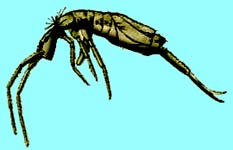
Our Friend the Springtail
Illustration courtesy of the
Texas A&M University Cooperative Extension
"Oh no! Help!" a novice gardener cried out in alarm. "I have little teeny jumping buggies in the soil of my garden! Are they killing my plants? How can I get rid of them?"
The short answer is "They're springtails. They're harmless. Don't worry about them."
Here's a more complete answer:
Not only are springtails harmless to the garden & do not bite, but their presence indicates good soil health. Their diet consists of decaying matter, fungus, & bacteria, & their activity helps keep nitrogen in the soil. A healthy garden & especially a healthy compost pile has them in abundance.
A radical explosion in their population might be an indicator that something in the organic balance is out of wack, though it probably means only that there is decaying mulch that delights them, or there are excesses of mushroom spoors which can increase springtail populations since springtails go after the mushroom spoors like kids after candy. A black variety of springtail called "snowflea" even hops around after snowfall gathering up fungal spoors from the surface of the snow.
If springtails vanish that means the microflora is probably also missing or soil is never sufficiently moist to support either springtails or microflora. In which case the plants, too, will be at greater risk.
It is sometimes recommended to get rid of them by letting the garden dry out, since they are susceptible to dessication, & tend to remain hidden except after rainfall or garden-watering. But attempting to get rid of them by drying out the garden would be equally harmful to microflora, except that the springtails would weather the drought better by moving to moist areas, possibly even inside the house, where they will accumulate in bathrooms & near kitchen sinks for the sake of moisture. They won't stay indoors if they can help it, because humidity inside houses is too low for them, & the decaying matter that makes up their diet is scarse. So they will either die off, or leave as soon as it's moist outdoors.
A large indoor infestation without an outdoor drought can be a warning-sign of mold problems inside the structure or leaky plumbing somewhere undetected. Insecticides won't get rid of them if there are condensation or moisture problems in the house, but correcting leaks & moisture problems or installing a dehumidifier does get rid of them.
Most springtails are so small (one or two millimeters) they will never be seen by the moderately farsighted. Tinier-than-average varieties are encountered in potted indoor plants, but they restrict their activity to the soil & don't spread elsewhere in the house, & are not harming houseplants.
There is one North American exception to the general harmlessness of the genus. A rounded stumpy flea-like springtail (Bourletiella hortensis) eats the delicate roots of evergreen tree seedlings, so if you are growing evergreen seedlings & had a population explosion of this flealike pest, that could be bad news.
Few are the gardeners with lots of tree seedlings, so the primary bad history for this critter is in tree farms & ornamental tree nurseries of the Pacific Northwest, where their feeding habits reduce seedling emergence or cause deformities of western hemlock, sitka spruce, & other evergreens, & cause lesions in developing bark, where harmful fungus can be established. They are most active in summer. When present & active they are easily detected by laying a white piece of paper on the soil & then blowing on or fanning the soil around the edges of the paper; if they are present in sufficient numbers to be harmful to evergreen seedlings, several will jump onto the white surface of the paper.
But if what one sees are elongated springtails (& most of the numerous species are elongated) then these are invariably harmless.
A similarly primitive hopping insect (far older than true insects) is the jumping bristletail. They're very nocturnal & feed primarily on the types of algae & lichens that grow on forest floors in leaf & needle litter. They can be very common in moist coastal forests where fallen leaves & debris are thick, which material jumping bristletails help turn into topsoil. They are rarely numerous in gardens. If there were many, you'd see them by turning over a piece of lumber or flat piece of bark. As with springtails, bristletails are harmless, & though they do eat living plant matter, it's only algae & lichens, not higher plants.
Although springtails are a sign of good healthy soil, many vendors of various pesticides nevertheless recommend getting rid of them. This is because chemical vendors don't care to distinguish between what is helpful & what is harmful, they just want to sell more of their products. Any garden pesticide that lists springtails or bristletails among the arthropods you should get rid of are lying to you about more than just that. They are lying to you about the abject safeness of their product, the primary effect of which will be to upset the organic balance of the garden creating more rather than fewer inroads for pests & diseases.
Even if there were an imaginary reason to control springtails, the method would be to clean up the leaf-litter from the garden. I'd never do this because springtail activity in leaf-litter constitute little factories for garden nutrients that help to limit the need to artificially fertilize. But if I had a phobia about springtails I'd sweep up all the leaves & that would automatically lower the springtail population.